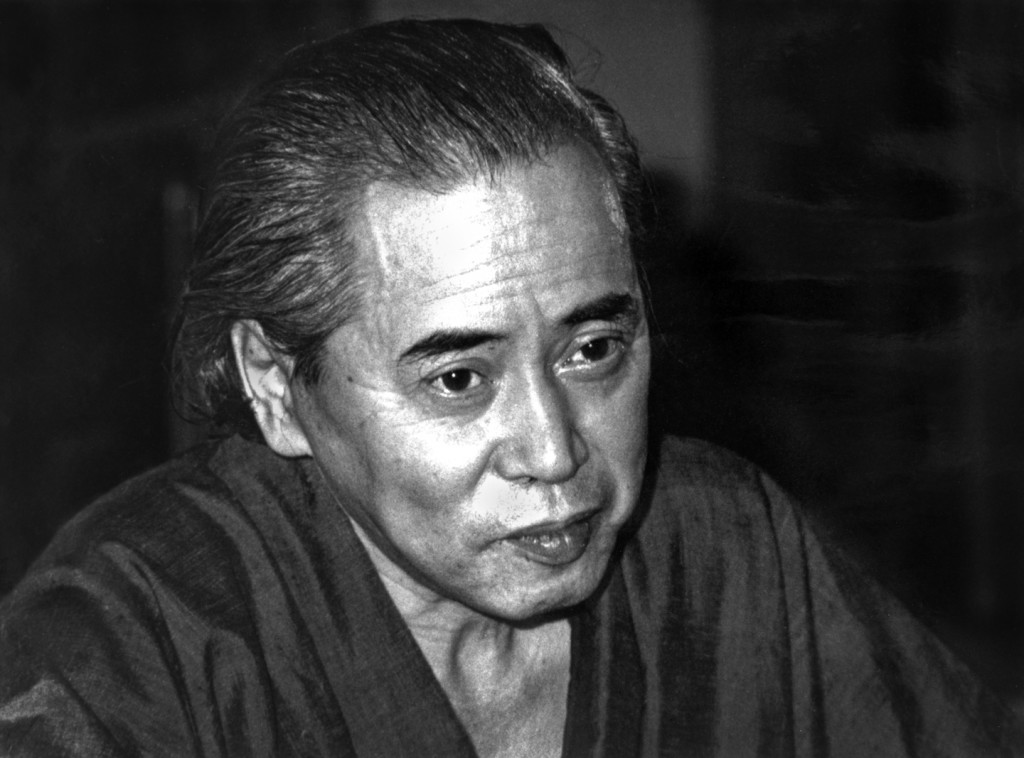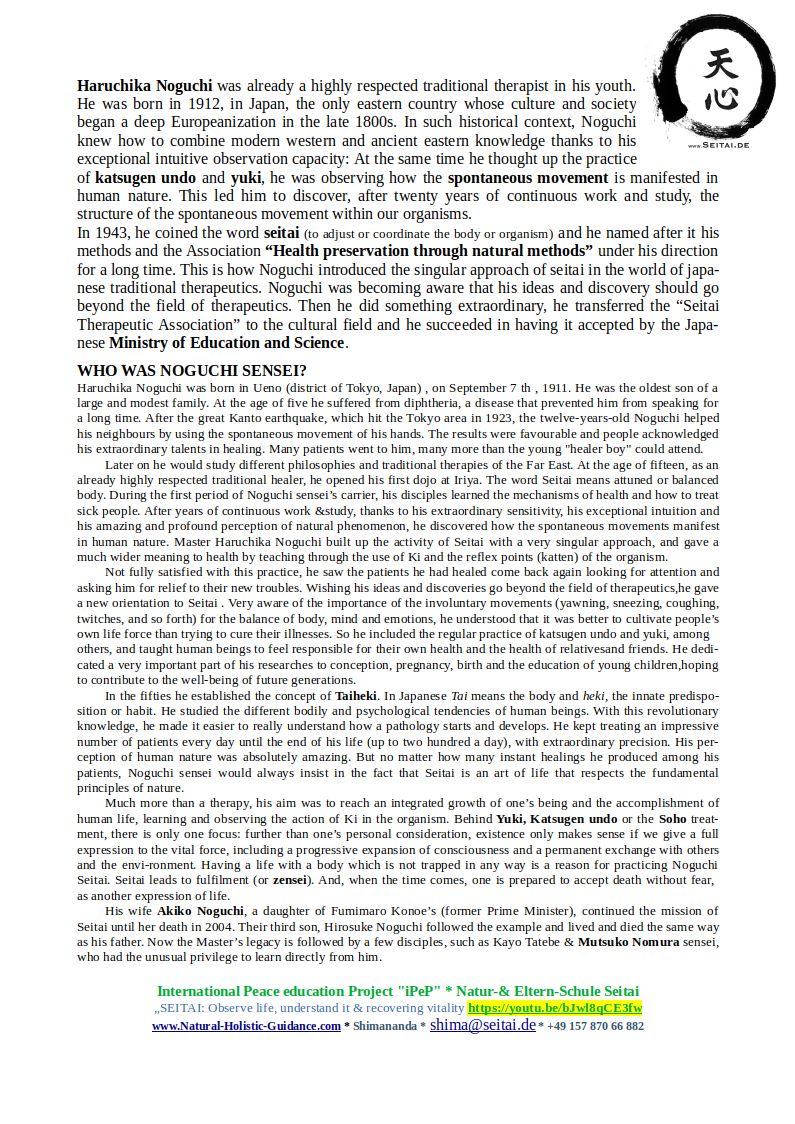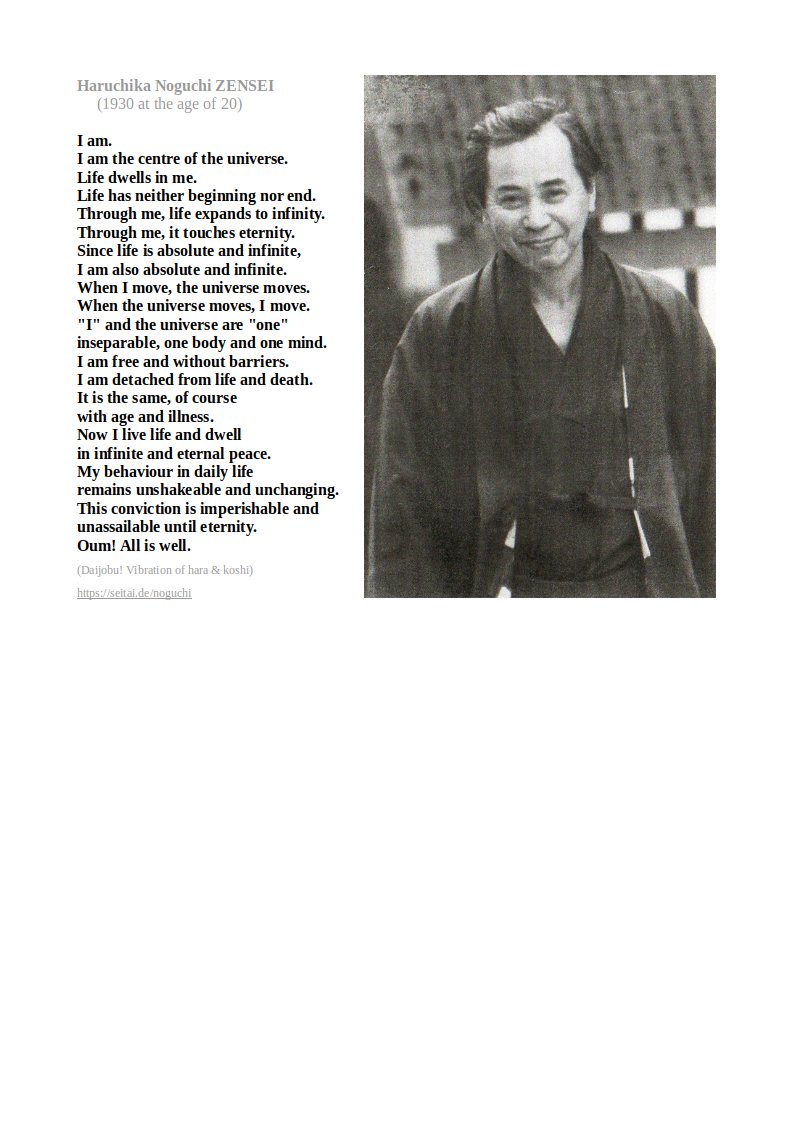Haruchika Noguchi

Haruchika Noguchi the Seitai-Founder was already a highly respected traditional therapist in his youth.
"Seitai" is registered & approved by the Japanese Ministry of Education & Science
Haruchika Noguchi was already a highly respected traditional therapist in his youth. He was born in 1911, in Japan, the only eastern country whose culture and society began a deep Europeanization in the late 1800s. In such historical context, Noguchi knew how to combine modern western and ancient eastern knowledge thanks to his exceptional intuitive observation capacity: At the same time he thought up the practice of katsugen undo and yuki, he was observing how the spontaneous movement is manifested in human nature. This led him to discover, after twenty years of continuous work and study, the structure of the spontaneous movement within our organisms.
In 1943-44, he coined the word seitai (to adjust or coordinate the body or organism) and he named after it his methods and the Association “Health preservation through natural methods” under his direction for a long time. This is how Noguchi introduced the singular approach of seitai in the world of japanese traditional therapeutics.
Meanwhile, Noguchi was becoming aware that his ideas and discovery should go beyond the field of therapeutics. Then he did something extraordinary, he transferred the “Seitai Therapeutic Association” to the cultural field and he succeeded in having it support by the Japanese Ministry of Education and Science. He founded the Legal Seitai Society (Shadan Hojin Seitai Kyokai) in 1956-57.

The master’s legacy is in the care of his children and his pupils in Seitai Kyokai.
WHO WAS NOGUCHI SENSEI?
Haruchika Noguchi was born in Ueno (district of Tokyo, Japan) , on September 7 th , 1911.
He was the oldest son of a large and modest family. At the age of five he suffered from diphtheria, a disease that prevented him from speaking for a long time. After the great Kanto earthquake, which hit the Tokyo area in 1923, the twelve-years-old Noguchi helped his neighbors by using the spontaneous movement of his hands "Yuki". The results were favorable and people acknowledged his extraordinary talents in healing. Many patients went to him, many more than the young "healer boy" could attend.
Later on he would study different philosophies and traditional therapies of the Far East. At the age of fifteen, as an already highly respected traditional healer, he opened his first dojo at Iriya.
The word Seitai means attuned or balanced body. During the first period of Noguchi sensei’s carrier, his disciples learned the mechanisms of health and how to treat sick people. After years of continuous work and study, and thanks to his extraordinary sensitivity, his exceptional intuition and his amazing and profound perception of natural phenomenon, he discovered how the spontaneous movements manifest in human nature.
Master Haruchika Noguchi built up the activity of Seitai with a very singular approach, and gave a much wider meaning to health by teaching through the use of Ki and the reflex points (katten) of the organism.
Not fully satisfied with this practice, he saw the patients he had healed come back again looking for attention and asking him for relief to their new troubles. Wishing his ideas and discoveries go beyond the field of therapeutics, he gave a new orientation to Seitai . Very aware of the importance of the involuntary movements (yawning, sneezing, coughing, twitches, and so forth) for the balance of body, mind and emotions, he understood that it was better to cultivate people’s own life force than trying to cure their illnesses.
So he included the regular practice of katsugen undo and yuki, among others, and taught human beings to feel responsible for their own health and the health of relatives and friends. He dedicated a very important part of his researches to conception, pregnancy, birth and the education of young children, hoping to contribute to the well-being of future generations.
His first “Seitai Therapeutic Association” (or Association of Seitai Soho) created in 1947, was reoriented and transferred to the field of culture and education. Noguchi sensei obtained the acknowledgement from the Japanese Government, and had it accepted by the Japanese Ministry of Education and Science. This way he founded the Legal Seitai Society (Shadan Hojin Seitai Kyokai) in 1956-57.
In the fifties he established the concept of Taiheki. In Japanese Tai means the body and heki, the innate predisposition or habit. He studied the different bodily and psychological tendencies of human beings. With this revolutionary knowledge, he made it easier to really understand how a pathology starts and develops.
However, he kept treating an impressive number of patients every day until the end of his life (up to two hundred a day) , with extraordinary precision. His perception of human nature was absolutely amazing. But no matter how many instant healings he produced among his patients, Noguchi sensei would always insist in the fact that Seitai is an art of life that respects the fundamental principles of nature. Much more than a therapy, his aim was to reach an integrated growth of one’s being and the accomplishment of human life, learning and observing the action of Ki in the organism.
Behind Yuki, Katsugen undo or the Soho treatment, there is only one focus: further than one’s personal consideration, existence only makes sense if we give a full expression to the vital force, including a progressive expansion of consciousness and a permanent exchange with others and the environment. Having a life with a body which is not trapped in any way is a reason for practicing Noguchi Seitai.
Seitai leads to fulfilment (or zensei).
And, when the time comes, one is prepared to accept death without fear, as another expression of life. The following thought defines Master Noguchi’s:
A deep sleep only exists for those who act fully
A peaceful death exists only for those that have lived this way.
In 1930, at the age of 19, he wrote Reflections of a full life,
a surprising text for such a young man:

Noguchi Sensei was an extraordinary human being. He lived and died according to this thought. He passed away in June 1976 at the age of 64, after a life devoted to his teachings. For fifty years he never had one day off. His wife Akiko Noguchi, a daughter of Fumimaro Konoe’s (former Prime Minister), continued the mission of Seitai until her death in 2004.
Their third son, Hirosuke Noguchi (popularly known as Roi sensei) followed the example and lived and died the same way as his father (he passed away in August 2014). Now the Master’s legacy is followed by a few disciples, an extraordinary women, Mutsuko Nomura sensei, who had the unusual privilege to learn directly from him.
Master Noguchi probably left his work unfinished. He discovered something huge and endless:
the structure of life, and life movement. Most of his teaching, related to everyday matters, were transmitted orally. He left many texts, and had some of his students write down his explanations during the workshops and training sessions. Unfortunately many texts of his biography have never been published (not even in Japanese) nor translated to western languages. Innumerable written examples illustrate Master Noguchi’s sensitivity and profound understanding.
Heiko yokyu no ni hoko (The two directions of the equilibrating desire)
Gohoko no shigueki han osei (five directions "taiheki" of the vital capacity of reaction to stimuli)
Ninguen no tankyu (New research about the human being "La Crianza")*
Taiundo no kozo (The structure of the spontaneous movement)
Kaze no koyo (Colds and Their Benefits)*
Books by Master Haruchika Noguchi translated in English*:
Order, Spontaneity and the Body. Tokyo, Zensei, 1984. ISBN 4-915417-00-X
Colds and Their Benefits. Tokyo, Zensei, 1986. ISBN 4-915417-01-8
Scolding & Praising. Tokyo, Zensei, 1991. ISBN 10: 4915417026- ISBN 13: 9784915417023
(Shimananda translated most of these important basic seitai books into german language*)
Noguchi-Seitai "katsugen-undo" life movement in Germany/bavaria/munich
WHAT IS SEITAI?
Seitai means healing from within. Everyone can do it.
The body moves spontaneously and success comes by itself.”
– Haruchika Noguchi
Literally translated, Seitai (整体) means “the harmonious body”. In this word, Tai (体) means the body. Seitai is a technique founded and developed in Japan by Master Haruchika Noguchi (1911-1976). The goal of practicing Seitai is to awaken life force, or Ki (気) and to cause energy to flow better. The primary principle behind Seitai is self-healing and training your body to heal itself.
The movement in Seitai called Katsugen Undo ( 活 元 運 動 ), is a spontaneous expression of the subconscious, or “movement which comes from life” as Master Noguchi used to say. Katsu means vital, or living, gen means the source, and undo can be translated as motion.
Katsugen Undo is stimulated using three preparatory exercises that awaken your body’s subconscious movements, which you can then observe and physically enact. With Katsugen Undo, you learn to reach your own energy, or Ki, and a natural state of centeredness through a series of spontaneous movements. Through this regenerating movement we can find the way back to our natural state, and we notice positive changes in our mind and body.
Other practices of Seitai are the techniques of Yuki, Katsugen Soho, or Seitai Taiso, among others, that help improve the sensitivity, feel the flow of Ki, and awaken the spontaneous movement from deep inside.
Inochi-no "Selfrealisation" by Shohin Kunio Nomura author of "beyond national egoism"
